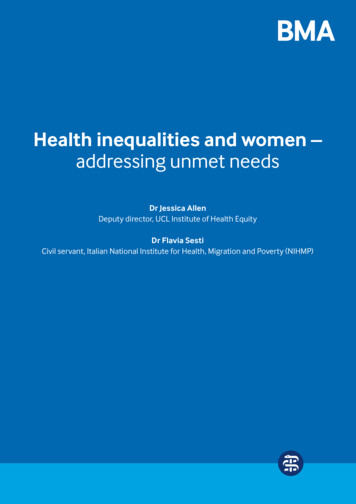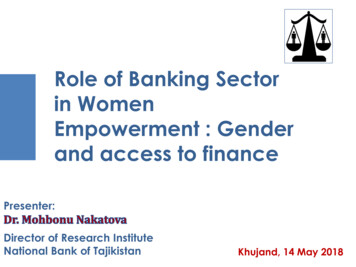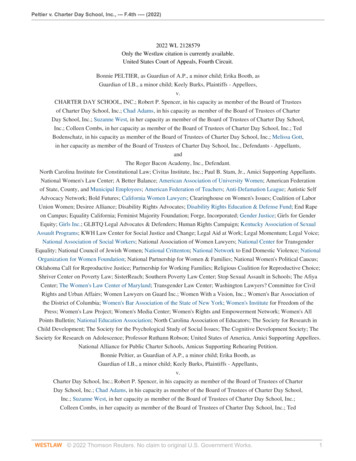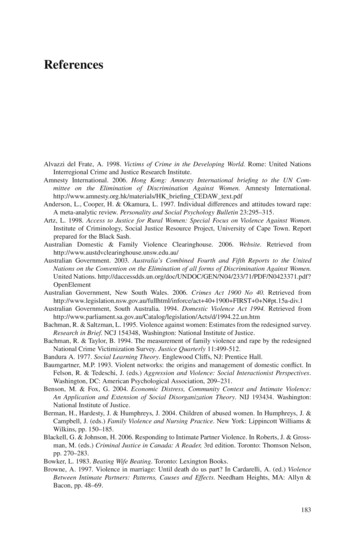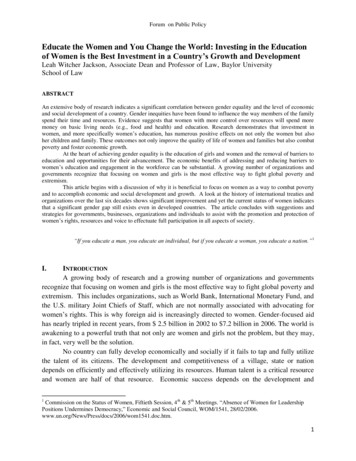
Transcription
Forum on Public PolicyEducate the Women and You Change the World: Investing in the Educationof Women is the Best Investment in a Country’s Growth and DevelopmentLeah Witcher Jackson, Associate Dean and Professor of Law, Baylor UniversitySchool of LawABSTRACTAn extensive body of research indicates a significant correlation between gender equality and the level of economicand social development of a country. Gender inequities have been found to influence the way members of the familyspend their time and resources. Evidence suggests that women with more control over resources will spend moremoney on basic living needs (e.g., food and health) and education. Research demonstrates that investment inwomen, and more specifically women‘s education, has numerous positive effects on not only the women but alsoher children and family. These outcomes not only improve the quality of life of women and families but also combatpoverty and foster economic growth.At the heart of achieving gender equality is the education of girls and women and the removal of barriers toeducation and opportunities for their advancement. The economic benefits of addressing and reducing barriers towomen‘s education and engagement in the workforce can be substantial. A growing number of organizations andgovernments recognize that focusing on women and girls is the most effective way to fight global poverty andextremism.This article begins with a discussion of why it is beneficial to focus on women as a way to combat povertyand to accomplish economic and social development and growth. A look at the history of international treaties andorganizations over the last six decades shows significant improvement and yet the current status of women indicatesthat a significant gender gap still exists even in developed countries. The article concludes with suggestions andstrategies for governments, businesses, organizations and individuals to assist with the promotion and protection ofwomen‘s rights, resources and voice to effectuate full participation in all aspects of society.“If you educate a man, you educate an individual, but if you educate a woman, you educate a nation.” 1I.INTRODUCTIONA growing body of research and a growing number of organizations and governmentsrecognize that focusing on women and girls is the most effective way to fight global poverty andextremism. This includes organizations, such as World Bank, International Monetary Fund, andthe U.S. military Joint Chiefs of Staff, which are not normally associated with advocating forwomen‘s rights. This is why foreign aid is increasingly directed to women. Gender-focused aidhas nearly tripled in recent years, from 2.5 billion in 2002 to 7.2 billion in 2006. The world isawakening to a powerful truth that not only are women and girls not the problem, but they may,in fact, very well be the solution.No country can fully develop economically and socially if it fails to tap and fully utilizethe talent of its citizens. The development and competitiveness of a village, state or nationdepends on efficiently and effectively utilizing its resources. Human talent is a critical resourceand women are half of that resource. Economic success depends on the development and1Commission on the Status of Women, Fiftieth Session, 4 th & 5th Meetings. ―Absence of Women for LeadershipPositions Undermines Democracy,‖ Economic and Social Council, WOM/1541, .doc.htm.1
Forum on Public Policyeffective utilization of the skills, education and productivity of all of its workforce. A growingbody of work shows a correlation between gender equality and the level of development ofcountries.2 Studies show that reducing gender inequalities enhances productivity and economicgrowth.3 United States Ambassador-at-Large for Global Women‘s Issues Melanne Verveer said,―We know that no country can prosper if half its people are left behind The truth of the matteris that countries that repress women also tend to be backward economically, and are more likelyto be failed states.‖4Gender inequities influence the way members of the family spend their time andresources. Evidence suggests that women with more control over resources will spend moremoney on basic living needs (e.g., food and health) and education. Research demonstrates thatinvestment in women, and more specifically women‘s education, has numerous positive effects,including: 1) reduction in female fertility rates; 2) lower infant and child mortality rates; 3) lowermaternal mortality rates; 4) increase in women‘s labor force participation; 5) fosters educationalinvestment in children.5These outcomes not only improve the quality of life of women and families but alsofoster economic growth. Economic benefits of addressing and reducing barriers to women‘seducation and engagement in the workforce can be substantial. A report by the United NationsEconomic and Social Commission for Asia and the Pacific Countries found the cost to the regionof restricting job opportunities for women is between 42 and 46 billion (USD) a year. Similarresearch by the World Bank also determined huge costs in the Middle East where only aboutone-third of women participate in the workforce.6 In Europe, a reduction in the male-femaleemployment gap has been an important driver of the economic growth over the last decade. 7 It isestimated that closing the gender gap could boost the United States Gross Domestic Product(GDP) by as much as 9%, the Eurozone GDP by as much as 13% and Japanese GDP by as muchas 16%.8President Obama in his June 4, 2009, address at Cairo University underscored thewisdom of investing in women‘s education and acknowledged the importance of theadvancement of women as a global issue. He then recognized that women‘s rights are a centralpart of the foreign policy of his administration. ―And it is no coincidence that countries wherewomen are well educated are far more likely to be prosperous Our common prosperity will beadvanced by allowing all humanity—men and women—to reach their full potential We mustrecognize that education and innovation will be the currency of the 21st century.‖92Hausmann, Ricardo, Laura D. Tyson and Saadia Zahidi, The Global Gender Gap Report 2008, World EconomicForum. www.weforum.org.3Id.4Ambassador-at-Large for Global Women‘s Issues Melanne Verveer on her recent visit to Afghanistan and the U.S.Commitment to Afghan Women. June 30, 2009. Available at ann, supra note 2.66Id.7Catalyst, ―The Bottom Line: Connecting Corporate Performance and Gender Diversity‖, 2004. www.catalyst.org.8Hausmann, supra note 2.9Remarks by the President on a New Beginning, Cairo University, Cairo, Egypt, June 4, 2009. Available atwww.whitehouse.gov/the press y.2
Forum on Public PolicyStriving for gender equality is not only a wise strategy, it also is a critical investment forthe future. To maximize its competitiveness and development potential, countries must work toprovide women with the same rights, responsibilities and opportunities as men.10This paper addresses the need to invest in the women of a country in order to achievedevelopment and growth and to address issues of social justice beginning with how focusedinvestment in women can achieve greater good than other investments. The history of efforts byvarious organizations is then discussed followed by a description of the current gender gap.Finally, a list of current and suggested activities is offered for consideration by governments,organizations, and individuals to assist with the gender equality efforts.II.WHY IT’S IMPORTANT TO ADDRESS WOMEN’S ISSUES IN PARTICULARInternational treaties and authorities agree that basic human rights should be enjoyed byall without discrimination. Basic human rights include personal safety, basic living needs—food,etc., health, education, job opportunities, wages, voice or vote, and property ownership. In all ofthese areas, however, women fall behind men almost universally. Yet research shows thatcreating greater gender equality helps create a fair society, raises economic productivity, andhelps advance other development goals.11 As United Nations Secretary-General Bautros-Ghalisaid, ―Without progress in the situation of women, there can be no true social development.Human rights are not worthy of the name if they exclude the female half of humanity. Thestruggle for women‘s equality is part of the struggle of a better world for all human beings, andall societies.‖12United States Ambassador-at-Large Melanne Verveer in testifying on violence againstwomen, said ―The underlying problems—gender inequality and the dehumanization of women—are often the same.‖13 The 2006 World Development Report labeled gender inequality as the―archetypal inequity trap.‖ The striking differences in access to assets and opportunities in manycountries has ―negative consequences for the well-being of women, families and society.‖14 Inthe 2007 Global Monitoring report, gender equity and the empowerment of women wereidentified as one of the two areas requiring greater international attention in order to createsustainable development and increase global growth.15A.Gender Equality Reduces Poverty and Has Greater Benefit to FamilyInvesting in women and empowering women lifts entire families, communities andcountries out of poverty. Studies, using cross-country regression, typically find that femaleeducation has a larger impact on economic growth than male education.16 ―[A]ll the data todayshows that investments in women have the single most effective payoff in terms of poverty10Hausmann, supra note 2.2007 Global Monitoring Report. World Bank. at-Large Verveer testifies on Women‘s Issues. May 14, 2009.142007 Global Monitoring Report, supra note 11.15Id.162007 Global Monitoring Report, Id. at pg. 108 Abu-Ghaida and Klasen 2004. Fn 6, chapter 3.113
Forum on Public Policyalleviation and the general prosperity of a country.‖17 Improved gender equality means increasedopportunity and higher income for women. Increased productivity and higher incomes raiseconsumption, investment and savings rates which assist with the overall status of the family.Gender equality also improves women‘s control over decision making in the household.Studies show that the greater the mother‘s control over resources the more resources householdsallocate to children‘s health, nutrition, and education. Thus, increased gender equality betweenmen and women in a household results in a larger share of resources devoted to children‘seducation and health. As one journalist explained, ―[s]ome of the most wretched suffering iscaused not just by low incomes but also by unwise spending by the poor—especially by men.Surprisingly frequently, we‘ve come across a mother mourning a child who has just died ofmalaria for want of a 5 mosquito bed net; the mother says that the family couldn‘t afford a bednet and she means it, but then we find the father at a nearby bar. He goes three evenings a weekto the bar, spending 5 each week.‖18Educated mothers are more aware of the benefits of immunization for their children andthey are fifty percent more likely to immunize their children than women who have not receivededucation. With more education, women delay marriage and getting pregnant, and they arebetter able to negotiate the number of children they have. Education can play a critical role inreducing violence against girls and women and enhancing their control over their own bodies.19Better maternal education also benefits children through improved hygiene practices, betternutrition, lower fertility rates, and hence higher per child expenditures. Taken together thesecontribute to future growth and poverty reduction.20In explaining his bank‘s decision to prioritize women when making micro-loans to thepoor without financial security, Muhammad Yunus, winner of the 2006 Nobel Peace Prize, said,"For women to be granted the loan has a definite effect on the family. There is no need to domore research on that today. Children benefit automatically, with better clothes and food. Wecan see the situation changing. Men often spend the money on themselves; women spend it onthe family. The bank's practice has meant a social revolution in Bangladesh.‖21B.Gender Equality Promotes Economic Growth and Stability1.MicroeconomicsEconomic gender differences have long been incorporated into economic analysis at themicroeconomic level. Economists have studied the differences in men‘s and women‘s economic17Ambassador-at-Large for Global Women‘s Issues Melanne Verveer on her recent visit to Afghanistan and theU.S. Commitment to Afghan Women. June 30, 2009. Available at olas D. Kristof and Sheryl WuDunn, Saving the World’s Women: How changing the lives of women and girlsin the developing world can change everything. N.Y. Times Special Addition, Aug. 17, 2009.19Kimotho, Rose W. ―Education as a tool of protection.‖ Conference on Women at Risk, University of New SouthWales, Sydney, Australia, 23-28 Nov. 2005.20A Longitudinal Study of the Impact of Integrated Literacy and Basic Education Programs on Women‘sParticipation in Social and Economic Development in Negal. Girls‘ and Women‘s Education Initiative and the Girls‘and Women‘s Education Policy Research Activity (GWE-PRA). Available at www.worlded.org.21Yunus, Muhammad (Founder of Grameen Bank.) 2006 Noble Peace Prize Presentation Speech.http://nobelprize.org/nobel ml4
Forum on Public Policybehavior, how these differences affect outcome and how they might influence public policies.For example, in studying the economic behavior of the household, economists have found that ahousehold‘s spending patterns depend on the share of the household‘s resources controlled bywomen or men. Women in control of their household‘s resources spend more on basicnecessities for the household and on the development of their children‘s potential.In view of these findings, in countries where women‘s opportunities to earn a living arelimited by cultural and economic factors, public policies could be geared to enhancing women‘semployment opportunities, directing benefits to their homes and their children, and ultimatelybenefiting their societies in a more effective way. Public policy decisions involving structuringprovisions of tax systems, spending programs, and social insurance programs should take intoaccount gender differences in economic behavior as well.22Also on a microeconomic level, microlending that favors women is a relatively newtrend. Microlending involves lending small amounts to poor people to finance small businesses.For small loans in amounts such as 50 to 100, women can start a business that will allow themto earn a better living for their family. In the beginning, microlenders were non-profitorganizations focused on community service. In recent years, however, larger for-profitcompanies have joined the practice. Microfinance is already a 30 billion industry and isprofitable for the investors with a 4.47% return for investors the past twelve months, comparedwith a 22% loss by the Standard & Poor‘s 500-stock index.23 Already more than 100 investmentfunds are focused on microlending.The concern for the future of this aid to the poverty issue is that microfinance is largelyunregulated, and lending practices remain relatively undefined. With the increased competitionin microlending and the struggling global economy, some lenders are loaning to more individualswith less defined plans and loaning more money to previous borrowers who are spending themoney not on starting new businesses but to buy non-necessity luxury items, such as televisionsets. A repeat of the global credit bubble, but in the microfinancing world, is expected by someto occur and perhaps burst.242.MacroeconomicsConsidering the impact of gender issues on macroeconomic issues is relatively recent. Ina 2006 survey by the Fiscal Affairs Department a number of key findings emerged from thereview of gender issues at a macroeconomic level. First, ―gender-based differences in behaviorthat are systematic and widespread can influence macroeconomic variables, such as aggregateconsumption, savings, investment, and risk-taking behavior.‖25 These differences, along with22Gender and Its Relevance to Macroeconomic Policy: A Survey, IMF Working Paper, Fiscal Affairs Department.Prepared by Janet G. Stotsky, Oct. 2006 International Monetary Fund WP/06/23323Copeland, Rob. ―For Global Investors, ‗Microfinance‘ Funds Pay Off – So Far.‖ The Wall Street Journal. Aug.13, 2009.24Gokhale, Ketaki. ―A Global Surge in Tiny Loans Spurs Credit Bubble in a Slum.‖ The Wall Street Journal. Aug.13, 2009.25Gender and Its Relevance to Macroeconomic Policy: A Survey, IMF Working Paper, Fiscal Affairs Department.Prepared by Janet G. Stotsky, Oct. 2006 International Monetary Fund WP/06/2335
Forum on Public Policywomen‘s increased political empowerment, may also influence public choice and the scope ofgovernment, which has macroeconomic feedbacks. Gender influences consumption behavior inpart through differences in behavior within the household. Women tend to devote a larger shareof household resources to meeting the household‘s basic requirements and to fostering theirchildren‘s potential. Gender influences savings and investment and risk-taking behavior.Women tend to have a higher propensity to save and to invest in productive ways. They alsoshow greater caution in their savings and investment behavior, which may often be good for poorhouseholds, though it can have mixed effects in the aggregate.26Second, as already discussed, ―there is a simultaneous relationship between women‘seconomic and social status and economic growth. The evidence shows that women‘s lack ofeducation, health care, and economic and social opportunities—both absolutely and relative tomen—inhibits economic growth while, at the same time, economic growth leads to a reduction inwomen‘s subordinated condition. In countries with the lowest average income and whereagriculture remains the main source of economic activity, women‘s lack of education, healthcare, and employment opportunities prevents them from being able to benefit fully fromimproved macroeconomic environments, hindering economic growth.‖27C.Women in Leadership Roles Improves PerformanceMore women serving in leadership roles not only contributes to the creativity that comeswith diversifying the minds that are addressing the issues, but also it can improve the bottom lineof an endeavor. A 2007 study from Catalyst found that on average Fortune 500 companies withmore women on their boards of directors had better financial performances than those with fewerthan three women board directors. Companies with the highest representation of women boardmembers outperformed those with the least number of women by 53% on the return on equity,42% on the return on sales and 66% on the return on invested capital measurements. Atcompanies with at least three women board of directors, return on equity was 16.7% compared tothe average of 11.5%; return on sales was 16.8% as compared to the average of 11.5%; andreturn on invested capital was a10.9% compared to the average of 6.2%. Similar correlationswere found across industries from healthcare to financial to information technology.28The presence of women leaders and the relationship to corporate performance was alsofound to have a close correlation. In a survey of 101 large corporations in Europe, America andAsia, companies with three or more women in senior management roles scored higher thancompanies with no women at the top in nine categories related to organizational excellence. Thesurvey covered a broad spectrum of industries and tested the areas of leadership, direction,accountability, coordination and control, innovation, external orientation, capability, motivation,and work environment and values.2926272829Id.Gender and Its Relevance to Macroeconomic Policy: A Survey, supra note 22.Catalyst, The Bottom Line: Corporate Performance and Women’s Representation on Boards, 2007.McKinsey study, Women Matter, October 2007. See Groundbreakers, Ernst & Young.6
Forum on Public PolicyAnother study in Europe found similar results. A study of 89 European listed companieswith the highest level of gender diversity in top management posts performed better financiallythan the average for their sector. The companies with women in top management positionsoutperformed their sector in terms of return on equity 11.4% to 10.3% for the average company.The ―Earnings Before Income and Taxes‖ was 11.1% versus 5.8% for the average. The stockgrowth price was 64% verses 47% over a two-year period. ―These statistically significant studiesshow that companies with a higher proportion of women on their management committees arealso the companies that have the best performance,‖ said the researchers.30III.HISTORY OF INTERNATIONAL WORK AND TREATIES TO PROMOTE GENDEREQUALITY AND EMPOWERMENT OF WOMENThe rights of women to be equal to men has been long been recognized by internationalorganizations and treaties. For the last six decades, domestic and global organizations haveworked to promote equality between men and women.A.United Nations and Its Commission on the Status of WomenThe United Nations‘ commitment to the advancement of women dates back to itsinception at the signing of the UN Charter in San Francisco in 1945. Of the 160 signatories, onlyfour were women - Minerva Bernardino (Dominican Republic), Virginia Gildersleeve (UnitedStates), Bertha Lutz (Brazil) and Wu Yi-Fang (China). These women succeeded in inscribingwomen‘s rights in the founding document of the United Nations. The preamble reaffirms thepeoples‘ ―faith in fundamental human rights, in the dignity of the human person, in the equalrights of men.‖31In February 1946, at the inaugural meetings of the UN General Assembly in London,United States delegate Eleanor Roosevelt read an open letter addressed to ―the women of theworld‖:―To this end, we call on the Governments of the world to encouragewomeneverywhere to take a more active part in national and international affairs,and on women who are conscious of their opportunities to come forward andshare in the work of peace and reconstruction as they did in war and resistance.‖At that General Assembly, a sub-commission dedicated to the Status of Women wasestablished under the Commission on Human Rights. Shortly thereafter, a request was made tochange the sub-commission into a full commission in order to give women‘s issues its dueattention. Bodil Begtrup (Denmark), first Chairperson of the Sub-Commission, stated to theEconomic and Social Council (ECOSOC) in May 1946:―Women‘s problems have now for the first time in history to be studied internationally assuch and to be given the social importance they ought to have. And it would be, in the opinion of30McKinsey study, Women Matter, October 2007. See Groundbreakers, Ernst & Young.This background note is based on the United Nations Blue Book Series on The United Nations and theAdvancement of Women, 1945-1996 and the United Nations CD-Rom Women Go Global, 2000.317
Forum on Public Policythis Sub-Commission of experts in this field, a tragedy to spoil this unique opportunity byconfusing the wish and the facts. Some situations can be changed by laws, education, and publicopinion, and the time seems to have come for happy changes in conditions of women all over theworld.‖32In June 1946, the Sub-Commission formally became the Commission on the Status ofWomen, a full-fledged Commission dedicated to ensuring women‘s equality and promotingwomen‘s rights. Its mandate was to ―prepare recommendations and reports to the Economic andSocial Council on promoting women's rights in political, economic, civil, social and educationalfields‖ and to make recommendations ―on urgent problems requiring immediate attention in thefield of women‘s rights.‖33Initially, the Commission focused its attention on raising awareness of women‘s issuesglobally and promoting women's political rights by trying to change discriminatory legislation.The first efforts of the Commission included data-gathering of the status of women in eachcountry. That data served as the basis for drafting a number of human rights instruments. Thenon-discriminatory law in marriage, literacy and access to education, violence against women,and equal pay were other areas of work of the Commission in the early years.34In 1967, the General Assembly adopted the Declaration on the Elimination ofDiscrimination against Women as an effort to consolidate standards on women‘s rights. In itsrequest of the Commission to draft the declaration in 1963, the Assembly noted that while therehad been measurable progress in achieving equal rights, ―in various fields there still remains, infact if not in law, considerable discrimination against women.‖35 Because the Declaration did nothave sufficient enforcement mechanisms, a more binding document was still needed.The Convention for the Elimination of All Forms of Discrimination against Women wasadopted in 1979 as a legally binding convention to define women‘s rights. The Convention, oftendescribed as the international women‘s bill of rights, was the first international instrument todefine discrimination against women, as follows: “any distinction, exclusion or restriction madeon the basis of sex which has the effect or purpose of impairing or nullifying the recognition,enjoyment or exercise by women, irrespective of their marital status, on a basis of equality ofmen and women, of human rights and fundamental freedoms in the political, economic, social,cultural, civil or any other field”. (art. 1) The 30 articles bring together in a comprehensive andlegally binding form internationally accepted principles on the rights of women. It commitsGovernments to take: “all appropriate measures, including legislation, to ensure the fulldevelopment and advancement of women, for the purpose of guaranteeing them the exercise andenjoyment of human rights and fundamental freedoms on the basis of equality with men”. (art. 3)Throughout its sixty years of existence and its fifty sessions, the Commission on theStatus of Women has consistently promoted the advancement of women. It has been instrumental32Id.ECOSOC Resolution establishing the Commission on the Status of Women. E/RES/2/11, 21 June 1946.34Short History of the Commission on the Status of Women. Available efhistory.pdf35Id.338
Forum on Public Policyin expanding the recognition of women‘s rights, in documenting the reality of women‘s livesthroughout the world, in shaping global policies on gender equality and empowerment of womenand in ensuring that the work of the United Nations is all areas incorporates a gender perspective.It continues to play a critical role by bringing together governments, UN entities, NGOs, andother international and regional organizations to promote women‘s rights and advance genderequality.36Today the Commission on the Status of Women is the principal global policy-makingbody dedicated to women‘s rights. Every year, representatives of Member States gather at UnitedNations Headquarters in New York to evaluate progress on gender equality, identify challenges,set global standards and formulate concrete policies to promote gender equality and advancementof women worldwide. One of the greatest achievements of the Commission on the Status ofWomen was the 1995 Fourth World Conference on Women, held in Beijing, which significantlyadvanced the global agenda for women‘s human rights and gender equality.37The challenge facing the Commission is further developing means to ensureaccountability for implementation of the existing policy framework at the national level.Capacity-building for mainstreaming gender equality is a long-term and ongoing process,requiring not only technical skills, data gathering, but also political will to advance the policyobjectives. Political will in turn is influenced by civil society and the private sector, requiringtheir involvement and support as well. They recognize the importance of establishing to allconstituents the integral links between human rights, development and peace.B.Universal Declaration of Human RightsThe United Declaration of Human Rights (UDHR) was the first international recognitionthat all human beings have fundamental rights and freedoms and it continues to be a living andrelevant document today. The UDHR is generally agreed to be the foundation of internationalhuman rights law. The UDHR was created just after the Second World War and the creation ofthe United Nations at a time when the international community vowed never again to allowatrocities such as those that had just been witnessed. World leaders decided to complement theUN Charter with a road map to guarantee the rights of every individual everywhere, always.Eleanor Roosevelt, widow of American President Franklin D. Roosevelt, chaired the UDHRdrafting committee.38The entire text of the UDHR was composed in less than two years. At a time when theworld was divided into Eastern and Western blocks, finding a common ground on the essence ofthe document proved to be a colossal task. The first draft of the Declaration was proposed inSeptember 1948 with over 50 Member States participating in the final drafting. On December 10,1948, the General Assembly, meeting in Paris, adopted the Universal Declaration of Human36Id.Id.38Id.379
Forum on Public PolicyRights with eight nations abstaining from the vote but none dissenting. Hernán Santa Cruz ofChile, member of the drafting sub-Committee, wrote:―I perceived clearly
wisdom of investing in women's education and acknowledged the importance of the advancement of women as a global issue. He then recognized that women's rights are a central part of the foreign policy of his administration. ―And it is no coincidence that countries where women are well educated are far more likely to be prosperous




